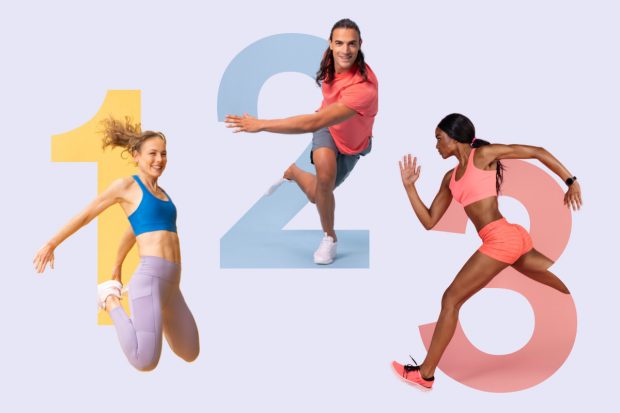Find out how your body’s 3 energy systems impact your workouts.

As soon as you start exercising, your body begins to burn energy. But the energy system you dip into is totally dependent upon the type, intensity and duration of the exercise you choose.
To get a bit nerdy, every single process in your body runs on adenosine triphosphate (ATP), a basic unit of energy in all living organisms, including humans. ATP is produced by 1 of 3 systems—phosphagen, glycolytic or oxidative.
The interesting thing here is that each of these energy systems rely on different fuel sources—carbs, protein or fat. Knowing which fuel source you’re burning during your workouts is really important for you, especially if you’ve set specific fitness goals for yourself to reach.
In this article, we’ll break down the body’s 3 energy systems to shed some light on the best way for you to train to reach your training goals.
The Phosphagen System

The phosphagen system is anaerobic, meaning it doesn’t require oxygen. All-out activities under 10 seconds, like sprinting, jumping or lifting heavy weights, rely on this system because a high amount of power is needed in a short amount of time.
Related: Anaerobic Exercise: What Is It and Can It Maximize Your Workout Routine?
No carbohydrates or fat is used in this process. Instead, the regeneration of ATP comes solely from stored creatine phosphate, the main high-energy, phosphate-storage molecule of muscle.
You might be asking yourself, what’s the point of training the phosphagen system if it doesn’t burn carbs or fat? The answer: Training in this environment enhances fast and powerful movements, which is particularly important for athletes. And if you’re a runner, that final kick at the end of a 5K relies on the phosphagen system to provide that extra burst needed to improve your PR.
The Glycolytic System

After the 10-second mark, your body transitions to the glycolytic system, which is the dominant means of energy production for up to 2 minutes. HIIT, boxing and interval runs are good examples of activities that utilize the glycolytic system as the main energy pathway.
Related: HIIT: Burn Fat, Build Lean Muscle and Transform Your Body
Carbs are the main source of energy used during this type of training. While you’ll start out producing energy anaerobically, after you surpass the 10-second mark, oxygen becomes a necessity. And because oxygen is needed, carbs are burned.
The more you train your glycolytic system, the faster you’ll recover between sets of moderate to high-intensity training. This is the perfect type of training if you want to gain lean muscle, lose fat and maximize your fitness results.
Many fitness trainers swear by this type of training and for good reason. Not only will you burn a significant amount of calories during these types of workouts, you’ll also continue burning calories long after your training session is over—a phenomenon known as the afterburn effect.
The Oxidative System

After the 2-minute mark, the oxidative system (aerobic system) takes over. The oxidative system uses both carbs and fat to produce ATP. Low-intensity aerobic activities like jogging, cycling and rowing, which require oxygen, predominantly rely on the aerobic system.
Related: The Pros and Cons of Steady-State Cardio
One of the main benefits of training the aerobic system is to improve your VO2 max, the maximum amount of oxygen your body can use.
During aerobic training, the body burns carbohydrates first, followed by fats. Proteins are only burned when the other two have been depleted, but you definitely don’t want to reach this point, since it breaks down muscle tissue.
Just to be clear, all 3 systems run at the same time, but one is emphasized more depending on what activity you’re doing. Arming yourself with the knowledge of all 3 systems will help you optimize your workout results.
Your Move
To break it down, if your main goal is to increase power, train your phosphogen system. If your main objective is to increase lean muscle and lose fat, train your glycolytic system. Last but not least, if you want to improve your VO2 max, add aerobic training to your routine.
You can also try adding all 3 energy pathways to your workout routine. For example, if you typically lift weights, adding cardio to your weekly routine will improve your endurance, allowing you to increase your training volume.
Or, if cardio is your go-to activity, adding strength training 2-3 days a week will boost your power output.
Looking for more ways to enhance your training? Find workouts that complement each energy system in the Gymondo app. Start your free 7-day trial today to level up your training.




Kommentar schreiben